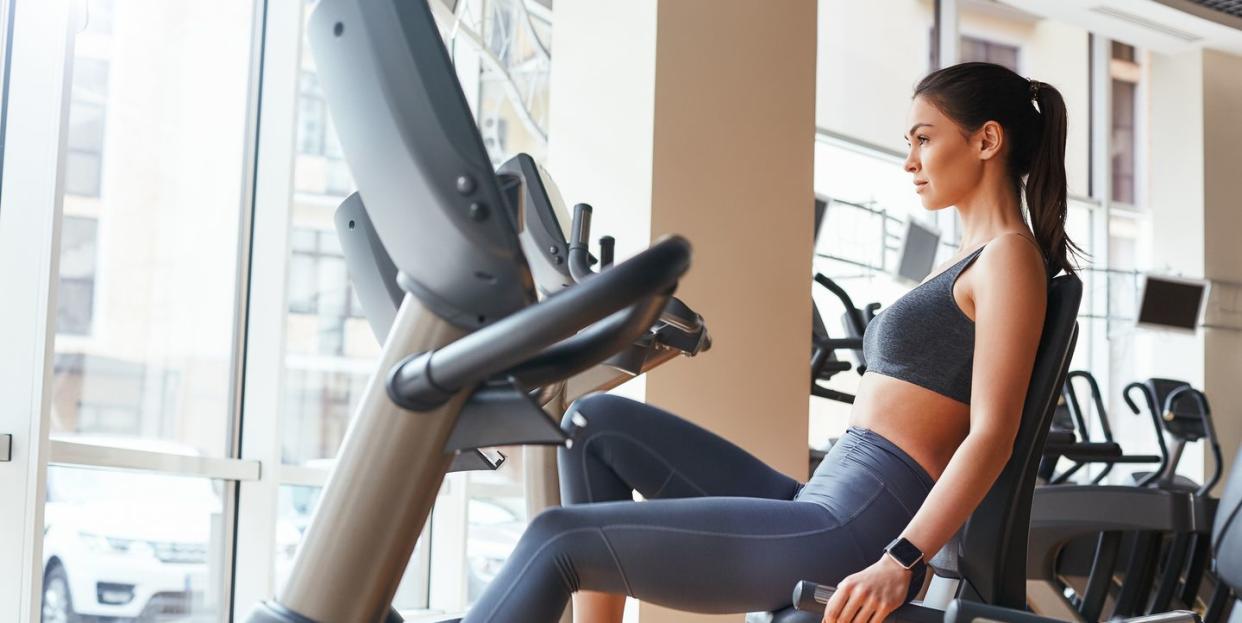Using a Recumbent Bike Is Easier on the Joints, But You Can Still Get a Good Workout

There are few forms of exercise that allow you to lean back and read a book while you work up a sweat. Pedaling away on a recumbent bike might appear to be a leisurely activity at first glance, but don’t be fooled: with high resistance settings and a hard effort, it’s not as laid-back as it looks.
More forgiving on the joints than hitting the treadmill or opting for an upright stationary version, the benefits of a recumbent bike include getting a solid indoor cardio workout. And, from an injury-recovery perspective, it’s a safe way to ease into joint movement and exercise during the healing process. Vint Schoenfeldt, physical therapist, C.S.C.S., and co-owner of Rocky Mountain Spine and Sport in Denver, appreciates the recumbent bike for how it helps his patients stay active as they heal or begin to exercise.
“My patients who use the recumbent bike often have a back issue—stenosis, for example, or degenerative disc disease—where they can’t tolerate the upright riding position, or it’s harder for them to get on and off a standard bicycle,” he says. “The larger seat also tends to be more comfortable for sitting and balancing, particularly for the elderly.”
Whether you’re using this machine for fitness or for rehabilitation at physical therapy, one benefit of the recumbent bike’s partially reclined position is a reprieve from the forward-leaning posture of regular bike riding. As a result, you’ll still be working your legs (and especially your glutes), but this position helps to avoid straining your back and hips. For those suffering from joint inflammation or any type of injury, this means a longer workout with less pain.
Despite the physical benefits that working out on a recumbent bike can offer, it’s all about personal preference; some consider the recumbent bike a bit too low-intensity and not enough of a core workout.
“Some people don’t care for them; they don’t like to pedal out front like that, and there is no weight-bearing movement involved,” Schoenfeldt says.
A regular stationary bike, which has the rider in an upright position and allows them to stand on the pedals during “climbs,” is what Schoenfeldt refers to as modified weight-bearing exercise; the reclining position of a recumbent takes that aspect out completely—which is a perk for riders looking to avoid that extra pressure on their back and joints, but a drawback for those who enjoy pushing their bodies to move with the bike and challenging their core strength.
So, if you’re not rehabbing an injury or trying to take it easy on your joints, is a recumbent bike a viable way of getting an effective workout? Schoenfeldt says it is, and recommends it for his athletes.
“The most common workout that I will give someone using a recumbent bike for their general fitness cardio workout is an interval program,” he explains. “It’s more about intensity than duration—so a higher intensity workout is best.”
A sample program Schoenfeldt suggests for a standard recumbent bike, which typically has 20 levels of intensity, is:
Warm up for 5 minutes at level 7 to 8, pedaling at 90 rpm
1 minute interval at level 15, pedal at 70-80 rpm
30 second recovery at level 1, pedal at 50 rpm
1 minute interval at level 15, pedal at 70-80 rpm
30 second recovery at level 1, pedal at 50 rpm
Continue this sequence for 20 minutes
Finish with 5 minutes of easy pedaling
To make this workout more challenging as you progress, increase your interval time.
“If you push hard enough and have enough resistance on there, you’ll get the cardio benefits,” says Schoenfeld. “I also know people who have outdoor recumbent bicycles that they take out on the road, and they get a good workout.”
You Might Also Like

